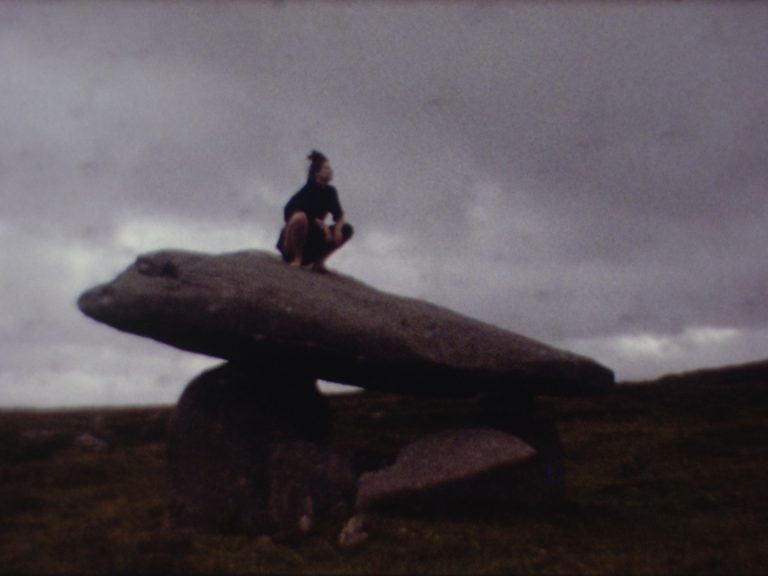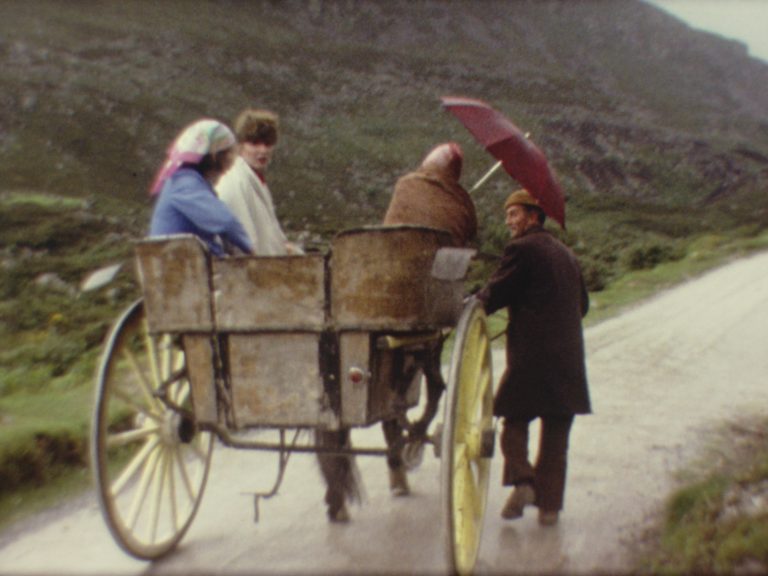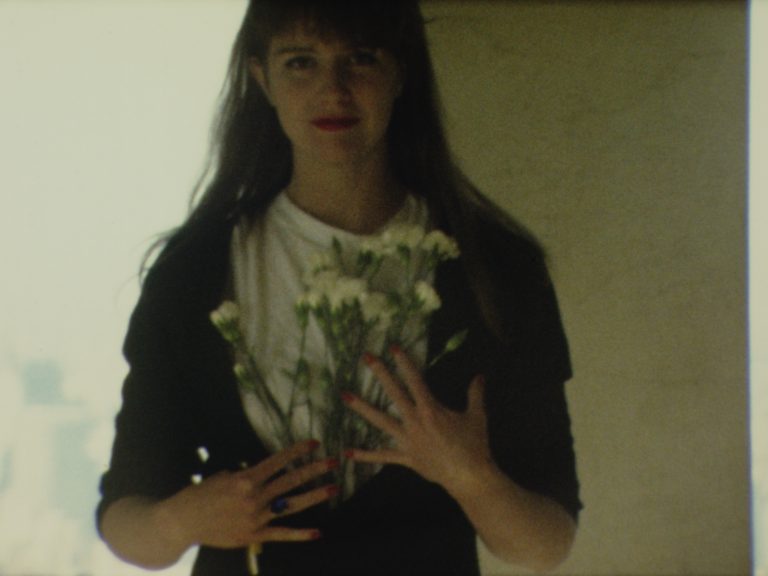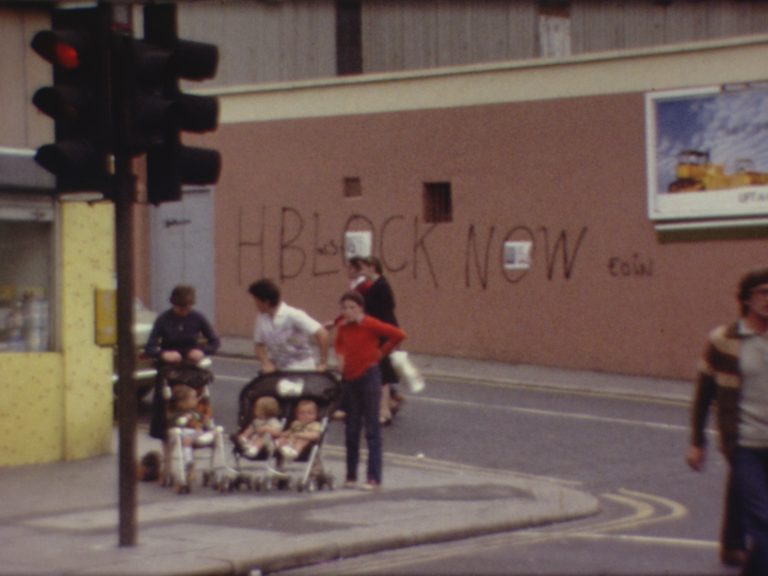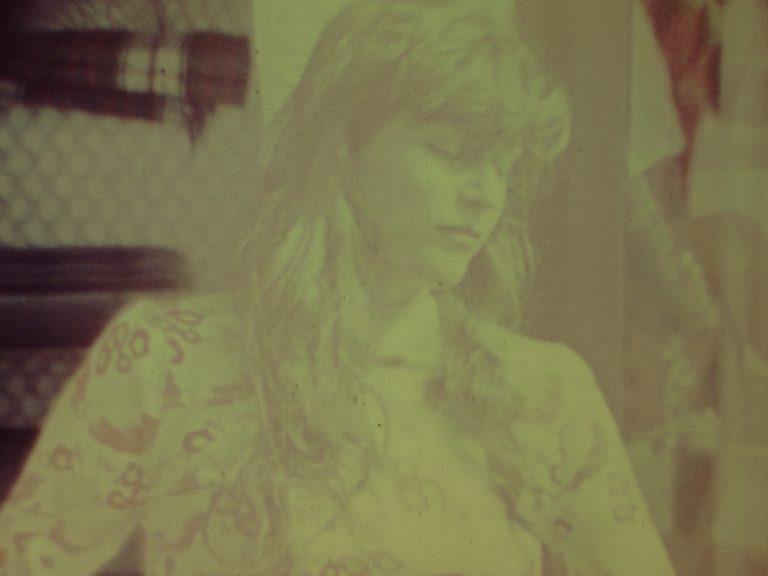IMMA Screen
IMMA Screen is an online screening series showcasing film and video works from the IMMA Collection. New screenings will be available monthly, presenting works by Irish and international artists alongside a new interview and related material from the IMMA Archive.
IMMA Screen is an online screening series showcasing film and videos from the IMMA Collection. New screenings will be available monthly, presenting works by Irish and international artists alongside a new interview and related material from the IMMA Archive. Each work will be accessible online for one month.
Artists’ moving image works have featured extensively in IMMA’s programming history since 1991 and form a key part of the Collection. Recently, many of these works have been digitised from analogue formats such as VHS tape and Laserdisc as part of a large-scale Collection & Programme Digitisation Project funded by the Department of Culture, Heritage & the Gaeltacht. This process preserves the works for the future while also allowing greater access to audiences and researchers. IMMA Screen highlights the Museum’s holdings of moving image work as a significant national collection of artists’ film and video.
Vivienne Dick, Visibility: Moderate
We are delighted to present Vivienne Dick’s Visibility: Moderate (1981) as the second work from the IMMA Collection to be showcased as part of IMMA Screen. The work was recently acquired for the IMMA Collection and will be presented as part of the upcoming exhibition Ghosts From the Recent Past.
In addition to the work itself, a new video interview between Vivienne Dick and Claire Walsh, Assistant Curator: Collections, IMMA, is also available further down this page. Alongside this, the artist has shared an audio recording featuring the voice of John Keeney, who appears in the film. These three short clips were recorded by Dick around 10 years after Visibility: Moderate was made. In the first part Keeney names the rocks along the peninsula at Drimanoo near Killybegs, this is followed by his memory of encountering a whale when out fishing in his small rowing boat and in the third part he tells about the time his brother set off for Scotland without telling anyone. Although not part of the film itself, this fascinating recording, carrys insight into the world and people captured by Visibility: Moderate. It is available to listen within the ‘Additional Resources’ section below. Further links there and in the ‘Explore More’ sections connect to talks, interviews and other content relating to 93% STARDUST, a survey exhibition of Dick’s work held at IMMA in 2017.
About the film:
Shot on a handheld Super 8 camera, Visibility: Moderate follows American tourist Margaret Ann Irinsky as she travels around Ireland taking in the sites, from the Puck Fair in Kerry to H-Block protests on the streets of Dublin, planting a kiss on the Blarney Stone and running barefoot through the fields. In parts, deliberately recreating scenes from popular John Hinde postcards of Ireland in the 1960s and 1970s. Scenes of windy landscapes, neolithic portal dolmens and busy shopping centres are interspersed with tv adverts and snippets from the radio, creating a sense of realities in flux. Part fiction, part documentary, Visibility: Moderate captures the many complexities and contradictions of an Ireland on the cusp of great change.
The tourist encounters a number of recognisable figures within Irish society at the time, including Mary Dunne or ‘Dancing Mary’, a regular performer on Dublin’s O’Connell Street, political prisoner Maureen Gibson, who was involved in the dirty protests in Armagh, and the voices of Nuala O’Faolain, Nell McCafferty and Frank Kelly captured on the airwaves. Other key subjects of the film are members of the Irish Anarchist movement, who the tourist spends time with on arriving in Dublin.
Visibility: Moderate offers a radical counterpoint to nostalgic representations of Ireland driven by the tourist industry. It brings together the familiar and the strange, documenting the artist’s own reckoning with the politics of her homeland, which, having spent the previous decade living in London and New York, she was encountering as both insider and outsider.
Screenings of the film include, the O-P Screening Room, New York, the 1983 Whitney Biennial followed by a US tour with the American Federation of the Arts, LUX cinema, Hoxton, London, Darklight Festival, Dublin (2007), Crawford Art Gallery (2009), Tate Modern (2010) and Seville European Film Festival (2016).
About the Artist
Vivienne Dick is an internationally celebrated filmmaker and artist. Born in Donegal in 1950 she began making Super 8 films while living in New York in the late seventies. Dick was a key figure within ‘No Wave’, a short-lived avant-garde scene in the late 1970s in New York led by a collective of musicians, filmmakers and artists including Nan Goldin, Lydia Lunch, Arto Lindsay, James Chance and many others.
She has gone on to develop an extraordinary body of work which has been shown in cinemas, film festivals and art galleries around the world. Dick’s work is marked by an interest in urban street life, social and sexual politics, and the history of ideas.
Retrospectives of her work include Seville European Film Festival (2016,) Tate Modern (2010), Crawford Art Gallery (2009), and Berlin Film Festival (1988). Group shows include Big as Life, MoMA, New York, The Whitney Biennial, Golden Thread Gallery and The Untold Want, RHA. Her work has shown at Oberhausen, Courtisane, BFI London, Lisbon Estoril, CPH: DOX Copenhagen and New York Film Festivals, amongst others. A DVD of three of her films was published by LUX and a collection was published by Crawford Art Gallery in collaboration with LUX in 2009. Dick has work is in the collections of MoMA, New York, Anthology Archives and the Irish Film Archives, and her films are distributed by LUX London and The Film Maker’s Cooperative, New York.
In 2017 IMMA presented 93% STARDUST, a survey exhibition of Dick’s work.
Additional Information
Additional Information
The first programme for IMMA Screen presents works by six artists over six months. Including Helen Cammock, Phil Collins, Vivienne Dick, Kevin Gaffney, Isabel Nolan and Alanna O’Kelly.
The first programme for IMMA Screen presents works by six artists over six months. Including Helen Cammock, Phil Collins, Vivienne Dick, Kevin Gaffney, Isabel Nolan and Alanna O’Kelly.
In different ways, these works engage with performance and the role of the camera in the construction and mediation of identity. From Isabel Nolan’s humourous explorations of performed identity in 'Sloganeering 1-4' (2001), to Phil Collins’ confronting insight into the depiction of war victims by journalists in 'How to Make a Refugee' (2000). In thinking about the psychological implications of newly imposed physical distancing between ourselves and others, the programme invites a timely reflection on the power and politics of representation and the continuous fabrications of the self and the other. A number of these works, including 'Sanctuary/Wastelands' (1994) by Alanna O’Kelly, also deal poignantly with ideas of loss and erasure.
